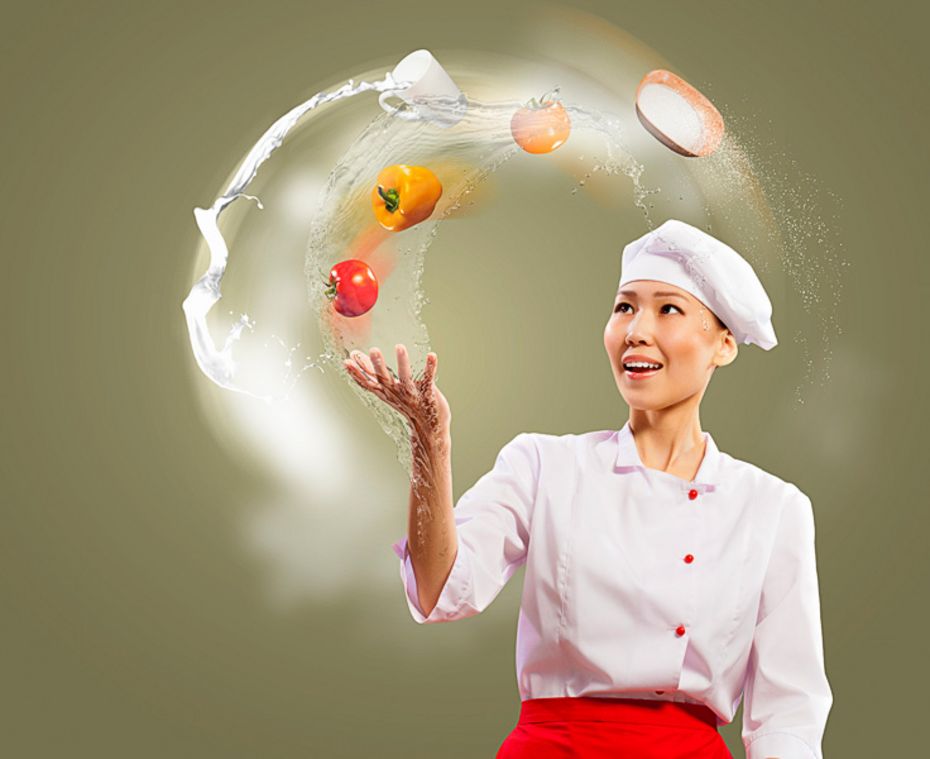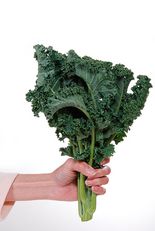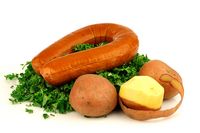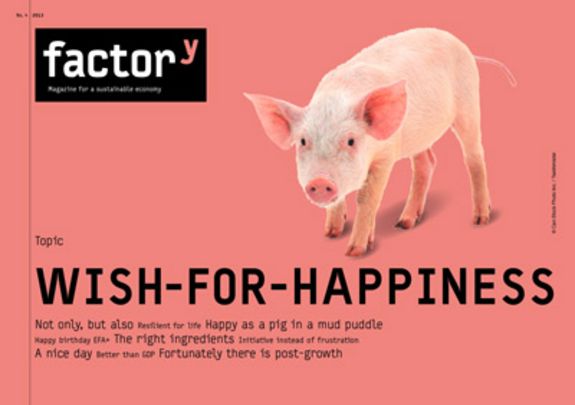Wish-for-Happiness

Culinary delight can make you happy. But a bite of delight cannot be bought – either in a delicatessen or in a fine restaurant. The keys to culinary pleasure lie in the mind and the senses, as is the case with curly kale or chocolate.
By Klaus Dahlbeck
Translated from the German by Olympia Klassen, Chantal Gruber and Kerstin Haep
Does curly kale make you happy? Wolfram Siebeck would answer that of course it doesn’t. For decades, he has been a culinary inspector and feared food critic on the German media scene. Just recently, the 85-year-old voiced devastating criticism about "the horrible stalk”, as he put it, in the German magazine Der Feinschmecker (the gourmet). According to him, there are many reasons to rate curly kale as an inedible luxury food. This raises the question of whether food can even make us unhappy. There is no information on curly kale yet, but the National Institute Of Health in Maryland, USA, suspects that the fatty acid DHA, which is found in numerous fish species, intensifies depression.
Does chocolate make us happy? There is no doubt about this if we believe the advertisements of the confectionery industry. Also, a number of studies prove that chocolate contains, in addition to sugar, four ingredients that can cause feelings of happiness: phenethylamine (PEA), anandamide, tryptophan and theobromine. PEA is a compound that is found in the human body in the form of, for example, a neurotransmitter like dopamine or a hormone like adrenaline. People in love always have a lot of PEA in their blood. Anandamide binds to the same receptor in the brain as tetrahydrocannabinol (THC), the intoxicating substance of the cannabis plant. In contrast, tryptophan is converted into serotonin in the body, the so-called happiness hormone, whereas theobromine is a compound that causes muscular relaxation and thus has an emotionally elevating effect. According to a study of the Department of Chemistry of the University of Madrid published in 2012, dark chocolate in particular, with 70 to 85 per cent of cocoa butter, contains a high percentage of serotonin and tryptophan. Could it really be true that only food with ingredients also contained in drugs can make us happy? It is appropriate to be sceptical about this, as the percentage of these substances in chocolate as well as in other foods like nuts and tomatoes is in general below the effect threshold. It would be best to return to the lovers once again, who do not need any chocolate to start the cascade of chemical processes evoking the feeling of happiness.
"I do not want any chocolate ..."

Or to say it with the words of an old German song by Trude Herr: “I do not want any chocolate, I want a man instead!”
According to science, good relationships to other people play the most important role for our feeling of happiness. So the kale enjoyed in a cheerful atmosphere with friends and a good glass of beer should make one happier than a bar of handmade high-quality chocolate that a lonely single person eats while watching television in the evening. Is this true?
With this question, the moment of truth should have come, because we also eat with our minds. Does the feeling of happiness still remain, even if we wonder during a meal in a cosy atmosphere if the smoked beef sausage in the splendid tasting kale comes from happy organic pigs? Does this feeling still remain if we lose our appetite already at the sight of the sausage because we fear for our figure? There is no doubt that true moments of happiness during a meal can only be experienced if worries are suppressed, if gourmets can eat without worrying because they know that the vegetables are free of harmful substances and that the animals do not come from intensive farming and if they don’t care about a few calories more or less. “Delight in abundance loses its value”.
"Delight in abundance loses its value"
However, those who are looking for their culinary happiness don’t need only the right products and pleasant company. Even a perfectly prepared favourite meal can be disappointing when eaten with the expectation that it tastes just like the meal our grandmother used to cook when we were a child. Even if it tastes exactly the same – after three days of eating the same meal, the culinary moment of happiness will hardly last forever. Delight in abundance loses its value and is as far from happiness as the smell of kale from the smell of chocolate.
Reason is a category that often pre-empts moments of happiness during meals, although all gourmets dream of the accidental discovery of a small restaurant, somewhere in nature, where they can stop for a bite to eat and realize that this is not only the very best authentic family cuisine available for a reasonable price, but also that the products come from the restaurant’s own organic farm. Getting more than you had even dared to dream of without high expectations: that’s happiness!
A positive surprise in the perfect moment is unfortunately a witty lover that only rarely puts in an appearance. So there has to be another way to find culinary happiness. Those who don’t want to rely only on coincidence could – with good prospects of success – try to adjust their own needs. This is an art we didn’t inherit. Who, as a child, hasn’t eaten so many sweets that he felt as if he was going to vomit? What memory remained of it? Do we still know what an enormous amount we ate at the seventh birthday of Susan or Thomas? We probably do not. We more likely remember the colour of the toilet lid in the bathroom of their parent's house.
Creating culinary lighthouses is a strategy that has something to do with adjusting one’s own needs. Instead of going to the Italian restaurant around the corner four times a month and always scarfing down the same pizza, you could go to an excellent restaurant every three months and be surprised by the chef's extraordinary creations. You will pay special attention to the smell and taste, and concentrate carefully on each dish. You will feel the crunchy, spongy and sparkling texture in your mouth, taste sweet, salty and sour ingredients and enjoy the smell of different spices. However, it is not only the attentive consumption of an impressively prepared meal that can lead to culinary moments of happiness, but also cooking in one’s own kitchen, for or with your family and friends. Experience how a recipe or an idea becomes a delicious meal. The great number of cookery programmes on television and their ratings show how great the longing is for cooking and food as a community experience, even though a smelling and tasting screen hasn’t been invented yet. Those who want to comprehend the importance of the social aspect of cooking nowadays and our deeply rooted desire for food as a community experience simply must consider the success of cooking shows. Although the transition to more flexible working hours and working places, the decline of the extended family and the sharp increase in the number of single households did change the reality of life, the longing for food as a community experience cannot be destroyed. Cooking shows are a reflection of this longing and probably contribute sometimes to subsequent actions.
Finally, it is not all that difficult to find culinary happiness if a few rules are taken to heart. For example, if we choose good ingredients from sustainable and ecological production that we do not have to worry about.
In the end, it is not too difficult to find culinary happiness with respect to some rules. Consumers could, for example, choose good ingredients from sustainable, ecological production to ease their conscience. They should learn to control their needs and to pay attention to the food, both while cooking and eating. Another issue is a realistic approach to their own expectations and the ability to enjoy the community. Taking these aspects into account, even kale can taste great – with or without sausage.
"You will feel the crunchy, spongy and sparkling ..."

Creating culinary lighthouses is a strategy that has something to do with adjusting one’s own needs. Instead of going to the Italian restaurant around the corner four times a month and always scarfing down the same pizza, you could go to an excellent restaurant every three months and be surprised by the chef's extraordinary creations. You will pay special attention to the smell and taste, and concentrate carefully on each dish. You will feel the crunchy, spongy and sparkling texture in your mouth, taste sweet, salty and sour ingredients and enjoy the smell of different spices. However, it is not only the attentive consumption of an impressively prepared meal that can lead to culinary moments of happiness, but also cooking in one’s own kitchen, for or with your family and friends. Experience how a recipe or an idea becomes a delicious meal. The great number of cookery programmes on television and their ratings show how great the longing is for cooking and food as a community experience, even though a smelling and tasting screen hasn’t been invented yet. Those who want to comprehend the importance of the social aspect of cooking nowadays and our deeply rooted desire for food as a community experience simply must consider the success of cooking shows. Although the transition to more flexible working hours and working places, the decline of the extended family and the sharp increase in the number of single households did change the reality of life, the longing for food as a community experience cannot be destroyed. Cooking shows are a reflection of this longing and probably contribute sometimes to subsequent actions.
In the end, it is not too difficult to find culinary happiness with respect to some rules. Consumers could, for example, choose good ingredients from sustainable, ecological production to ease their conscience. They should learn to control their needs and to pay attention to the food, both while cooking and eating. Another issue is a realistic approach to their own expectations and the ability to enjoy the community. Taking these aspects into account, even kale can taste great – with or without sausage.
The journalist Klaus Dahlbeck has been writing about enjoyment in all its culinary facets for a long time.
More articles to the topics of happiness, wishes and the good life you will find either online or in our magazine Wish-to-Happiness. Finly illustrated and lightly readable on tablet-computers and screens the PDF-magazine contains all articles and pictures as well as additional numbers and quotatians.
Beiträge online
WISH-FOR-HAPPINESS

- Not only, but also
- Resilient for Life
- The right ingredients
- Initiative instead of frustration
- A nice day
- Zum Glück gibt es das Postwachstum
- Besser als BIP
Themen
- The Domino Effect: the Mobility Transition as an Engine for the ‘Great Transformation’
- Cities Use the Space
- Decarbonization by 2030
- The fear of biting the hand that feeds you
- Where investing is a pleasure
- Why divestment is going to change the world
- A Robin Hood tax for climate protection
- May the Force Be with Us
- Modern Strategies
- The prerogative of interpreting the future now lies with the companies involved in climate protection”
- From Negotiating to Trading Equitably
- Can a donkey be tragic?
- Rethink rather than rebound: a sufficiency revolution must precede the efficiency revolution
- On Rebound, Prebound and Performance Gaps
- So Let Us Seize Power Then!
- With Common Property Against Political Failure
- So Let Us Seize Power Then!
- The Comforting Beauty of Failure
- “It Is Not Impossible at All.“
- Resource-light shopping
- Men Have Not Stopped Giving the Advantage to Women – So Far
- Toothpaste for Princesses and Soup for Pirates
- It is about equality
- A nice day
- Initiative instead of frustration
- The right ingredients
- Resilient for Life
- Not only, but also
- Appreciation – more please!
- Worth more than money
- Learning to value the value of goods
- Worth and Values
- The Transformative Power of Science
- Historically effective: How innovation and technology transform
- The Disappearance of Products
- Growing Older 101
- Columbus’ Egg
- It Works! In Theory at Least ...
- What If...?
- Analysing Separately – Thinking and Acting Together!
- Let’s Break Away from Determined Breaking Points
- More Gold in Waste than in Mines
- The art of separation
- Should you really DIY?
- The Aesthetics of Do-It-Yourself
- Standing on One’s Own Feet
- From the handaxe to desktop fabrication
- Using Shares to Survive the Crisis
- When Citizens participate
- Possess to Participate
- The Right Growth at the Right Time
- Gunter Pauli and Blue Economy
- When Sustainability Grows
- How we treat Growth
- Illusions about Growth

